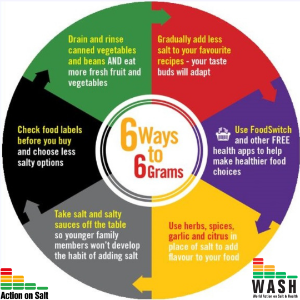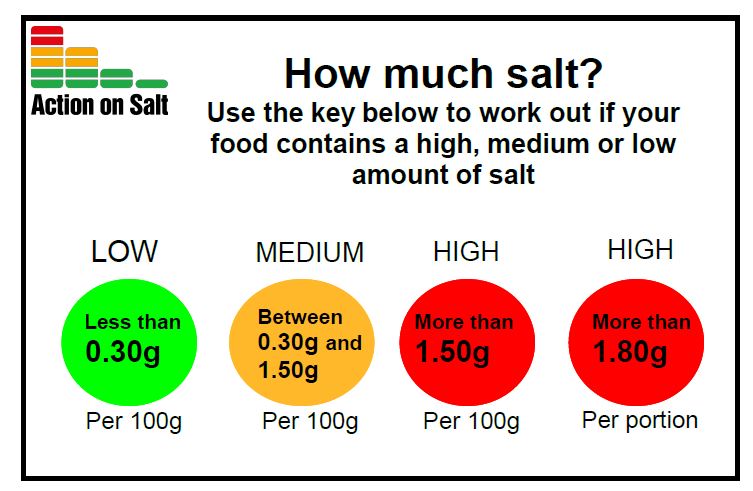Reducing salt intake
Follow our 6 steps to 6 grams 
- Slowly reduce the amount of salt you use while cooking - your taste buds will adapt
- Use herbs, spices, lemon, garlic and fresh chilli when cooking to add flavour in place of salt
- Drain and rinse canned vegetables and beans if they are stored in salted water!
- Check food labels to check salt levels and choose the lower salt option. No nutrition levels? Write to the manufacturer to ask why!
- Take salt shakers and salty sauces off the table so younger family members don't develop the habit of adding salt to their food
- Use the FREE FoodSwitch app to scan the barcodes of your food and drink products to instantly see whether they are high (red), medium (amber) or low (green) in fat, saturates, sugars and salt per 100g. It also searches the database for similar but healthier alternative products, making it easier than ever to switch to healthier food choices
Top Tips
- Remember sea salt and rock salt have the same effect on the body as normal table and cooking salt
- Try reducing the amount of salt you add gradually over a couple of weeks, allowing your taste buds time to adjust
- If you can’t get used to less salt, try using low sodium alternatives such as LoSalt and gradually reduce how much you add till your taste buds adapt to no added salt or sodium alternatives
Shopping
- See our shopping guide: PDF Leaflet - Shopping Guide [PDF 606KB]:
- Swap high salt ingredients for lower salt alternatives
- Tinned tuna in brine → tinned tuna in water
- Smoked salmon → fresh oily fish
- Ham and cheese sandwich filling → fresh sliced chicken and salad
- Salted butter → unsalted butter
- Prepacked salted popcorn → fresh popped unflavoured popcorn
- Salad dressings or mayonnaise → Fresh herbs, balsamic vinegar or lemon juice
- Instant noodles → make your own with plain noodles, vegetables and fish or meat
- Pizza with high salt toppings e.g. anchovies, olives, pepperoni, marinated meats → Pizza with lower salt topping e.g. grilled chicken, peppers, mushrooms, sweetcorn
- Swap high salt ingredients for lower salt alternatives
- Always remember to check the labels and choose lower salt option
- Look for lower salt and ‘no added salt’ versions of your usual foods in the supermarket e.g. canned vegetables, tinned fish in spring water, ketchup and baked beans
- Reduced salt doesn't mean 'low in salt'. There may be other brands lower in salt
- Check the portion size stated on the packaging to see if this is simiar to the amount that you or your child will actually eat
- If salt is only given per 100g
- Step 1 - Calculate how much salt there is per gram by dividing the amount of salt per 100g by 100
- Step 2 - Check the weight of a recommended portion as stated on the pack, is this realistic for you? Work out how many grams you or your child will realistically eat
- Step 3 - Finally, work out how much salt there is per portion bu multiplying the figures from step 2 and step 3
Cooking
Our recipes are FREE to access and download online. Whether you're looking for a breakfast, lunch, dinner or snack idea - we have you covered!
Marinade combinations:
- Chicken or Pork: Honey, ginger, garlic and olive oil
- Lamb: Ginger, coriander, lime zest and juice
- Beef: Black pepper, chilli and vegetable oil
- Fish: Chopped fresh dill, olive oil and lemon juice
- Tofu: Honey, ginger, garlic and olive oil
Other flavours:
- Basil:
- Good with: pasta sauces, pizza, pesto, dressings
- Cardamon:
- Good with: curries
- Chilli:
- Good with: sauces, curries, dressings
- Chives:
- Good with: potato salads, other salads, eggs
- Cinnamon:
- Good with: chicken, pork, lamb, fruit desserts (crumbles), casseroles, porridge, roasted vegetables
- Citrus
- Olive oil, lemon juice and black pepper: salads and boiled new potatoes
- Lemon juice and chopped mint: peas and green beans
- Lime juice: stir fries, curries and lamb dishes
- Grapefruit/Orange: salads
- Lemon juice: to crisp up the skin on a chicken
- Zest of lemon or lime: curries
- Orange slices: casseroles
- Coriander:
- Good with: soups, curries, fish and chicken
- Cumin:
- Good with: lamb, rice, beans and pulses
- Dill:
- Good with: fish, seafood, potato salads, cheese and eggs
- Fruit
- Sultanas and cinnamon: hot pilaf or cold rice salad
- Chopped dired apricots, mixed spice and toasted almonds: couscous
- Apricots or prunes: meat casseroles
- Ginger:
- Good with: stir fries, curries, fish, dressings
- Mint:
- Good with: peas, broad beans, salads
- Nutmeg:
- Good with: soups, white or cheese sauces
- Oregano:
- Good with: pasta sauces, bread, salads
- Paprika:
- Good with: casseroles, fish, chicken, soup
- Parsley:
- Good with: roast meat, pesto, salad, fish, dressings
- Rosemary:
- Good with: roasted vegetables, roasted meat, pasta sauces (i.e spaghetti bolognese)
- Saffron:
- Good with: rice, chicken
- Sage:
- Good with: meat, stuffing, pasta
- Tarragon:
- Good with: chicken, casseroles, pulses
- Thyme:
- Good with: pasta sauces, roasted meat, casseroles, roasted vegetables
- Turmeric:
- Good with: curries, eggs, meat, rice, couscous



